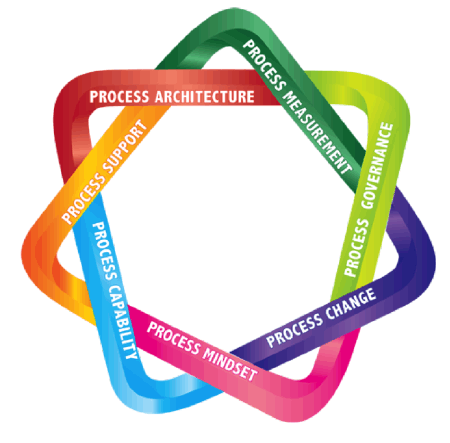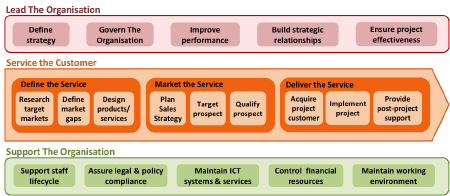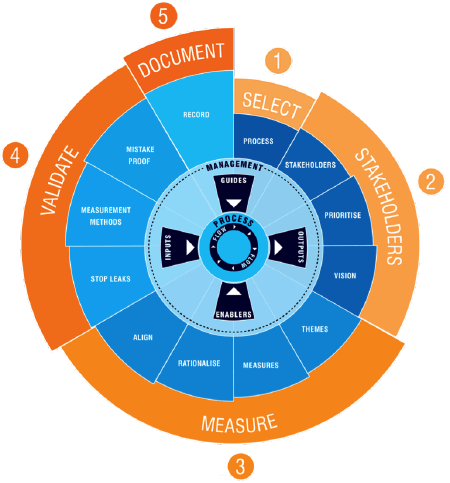Putting Process at the Centre of Business Management (Part 1)
An impasse
The time has passed when improving performance can be achieved by 'simply' reducing budgets and assuming those affected will adjust to the change. After years of budget cuts and efficiency dividends, the easy changes are done, contingency resources are extinct, and further change is deep, structural, and difficult. Resource scarcity dominates decision making, and the need to 'do more with less' seems both inevitable and impossible.
The predictable results of repeated, untargeted, broad-based reductions in available resources are often reduced service levels, extended delays, increased personal and team stress, and a general reduction in organisational performance. Unfocused reductions cause dysfunction, not efficiency. Short-term gains in the current financial year might mask the accumulating pain, but they can neither avoid nor remove it.
Across the spectrum of public, private, and not-for-profit sectors, many organisations are faced with the complex dilemma of dealing effectively with major operational challenges such as radically-increased customer expectations, snowballing cost pressures, shrinking budgets, mounting regulatory compliance, diminishing staff numbers, increasing operational complexity, and fragile workforce enthusiasm.
A repeated cycle of job cuts cannot provide the ultimate sustainable answer. A recent newspaper article provided a chilling insight into contemporary corporate life: "Staff in the department have been told that budget cuts inflicted by the government have made the job cuts 'an urgent task' and they have been warned of even more pain to come."[1] That comment refers to a public sector agency, but many in the private sector will find the general circumstances disturbingly familiar.
In the real world there may have to be some job cuts, but that can no longer be the only, or even main, response to the requirement to do more with less. There also has to be a more nuanced response that focuses on doing the necessary work as efficiently as possible, removing the wasted time and costs, being much more forensic in the discovery of effective change, and continuously realising sustainable benefits. A new culture of process innovation and improvement is needed.
A government regulatory agency recently increased the number of compliance inspections it was able to achieve by 500% without any change in workforce. It achieved this by better understanding the related business processes, carefully removing unnecessary steps, redesigning to eliminate delays, enhancing stakeholder education, and automating some (but not all) activities.
There is a better way. Look around your organisation. Can you see areas where work could be done more efficiently and effectively? We all can, and we should do something about it.
So, what can we do?
This article describes the theory and practice of process-based management. More commonly known as Business Process Management (BPM), this approach refocuses management on the ways an organisation delivers value to its customers and other stakeholders. The focus is on the way work gets done and what impedes it being done in the most straightforward, efficient, and effective way. BPM is not about technology; it is not an IT solution but a pragmatic management approach.
The approach described here has been proven to work in organisations irrespective of size, industry sector, and circumstance. It's not trivial to implement, but neither is it so difficult as to justify leaving it in the 'too hard basket'.
There is no technical jargon in this article. The discussion is based on a common sense analysis of how work gets done. While the detail is left for another time, clear and practical suggestions are made as to how the seven enablers of process-based management can be achieved, resulting in significant organisational performance improvement.
There are many examples where BPM approaches have delivered real operational benefits — reducing costs, innovating product and service delivery, improving customer satisfaction, enhancing staff morale, and decreasing waste.
A corporation involved in the approval of service change requests was receiving serious complaints about the time taken to process applications. These complaints were coming from major stakeholders and the situation was critical. The complaints were justified, as the data showed that while the average approval time was four weeks, it ranged from two to twenty weeks. Careful analysis and modelling of the business process, removal of delays, changes to work allocation, and improved applicant awareness all contributed to a dramatic improvement, with complex applications now completed in six weeks, simple ones in two weeks, and both with a guaranteed variability limit of +/- one week.
Defining process-based management
Before moving to the substantive content of this article, it is well to first define the terms business process, process improvement, and process management. These are key concepts, and many different definitions — and understandings of them and approaches to them — can be found in the literature.
Business processes are collections of cross-functional activities. They describe the sequence of activities required to achieve some outcome. By definition, business processes are the only way any organisation can deliver value to customers and other stakeholders. By themselves, the separate functional areas of an organisation cannot deliver value to external parties. Test that idea — can you name an entity on your organisation chart that, by itself, can deliver value to an external customer? I know you can't; nobody can.
An organisation's resources are managed 'vertically' via the organisation chart. Value is created, accumulated, and delivered 'horizontally' across the organisation chart. Value is accumulated, not up and down the functional organisation as represented in an organisation chart, but across the organisation as the various parts collaborate to create, accumulate, and deliver value in the form of a desired product or service. Business Process Management (BPM) is not a one-off project, nor an IT system; it is a management philosophy. It follows that an organisation executes its strategic intent via its business processes. The profound sequence from strategy to execution is shown in the breakout box, From Strategy to Execution.
In this context, where cross-functional processes are key to the delivery of value to customers and other stakeholders (including the organisation itself), the improvement and management of processes is critical to the optimisation of performance. The definition, improvement, and management of business processes include all the resources involved in the execution of each process.
How organisations can achieve even more with even less by identifying, analysing, improving, and managing business processes is the subject of the rest of this article.
Taking a business process view
Discovering, documenting, improving, and actively managing cross-functional business processes can expose significant opportunities for getting more work done with the same, or perhaps even fewer, resources.
The power of process-based management is in understanding how work gets done and, based on that understanding, eliminating impediments, streamlining activities, and removing waste. The focus is on how the process, including all of the people and resources involved, delivers value to the customer and other stakeholders. This cross-functional focus is missing in most organisations, where it is replaced with an internal management emphasis guided by the organisation chart.
There are seven elements that come together to support process-based management:
- Discovering, understanding, and documenting the organisation's processes in a hierarchical model — Process Architecture
- Defining process performance measures and measurement methods, along with collecting and reporting performance data — Process Measurement
- Responding to the reported process measurement data by taking appropriate action to address actual or emergent performance anomalies — Process Governance
- Continuously discovering processes that can perform better and finding ways to close the performance gaps — Process Change
- Creating an environment where the organisation, its people, and their teams are always conscious of the processes in which they participate — Process Mindset
- Developing the tools and skills required throughout the organisation to identify, analyse, improve, and manage business processes — Process Capability
- Providing the support required throughout the organisation to develop, sustain, and realise the benefits of process-based management — Process Support
These seven enablers are shown in Figure 1. A Mobius strip format is used to highlight the interdependencies between the elements.

Figure 1. Seven Enablers of Process-Based Management.
The core artefact is the process architecture since documenting the key processes is the necessary first step. Once documented, processes can be measured, and once we have measures we need the governance arrangements to define who should respond to the performance reports. These first three enablers (architecture, measurement, governance) are the 'physical infrastructure' on which the rest is built. Continuous process improvement is the cornerstone of process-based management. Without process improvement — and its big brother process innovation — all else is waste. For process management and improvement to become ubiquitous, it must be embedded in the organisation culture. Having a central specialist group to do all process work does not scale and will soon impose a bizarre restriction on process management and improvement work. Therefore, it is necessary to build the capability for identifying, analysing, improving, and managing business processes throughout the organisation.
An overview of each of the seven enablers of process-based management is provided in the following sections.
Process Architecture
A Business Process Architecture is a hierarchical model of the processes of an organisation. Usually created (initially, at least) to include the two or three highest levels, the process architecture provides a powerful visualisation and management tool.
The process architecture includes not just the hierarchical description of process activities but also the related resources, documentation, performance measures, measurement methods, and governance arrangements.
The simple, but indicative, process architecture shown in Figure 2 is an abridged version of an architecture recently developed for an IT service vendor.

Figure 2. Business Process Architecture Example.

A well-formed Business Process Architecture is a powerful management and decision-making tool and can be used to:
- visualise the organisation's set of business processes,
- understand how the organisation's strategic intent is executed,
- communicate business process information,
- concentrate organisational focus on value delivery,
- understand the business process interdependencies,
- prioritise process analysis and improvement activity,
- coordinate process improvement project portfolio management,
- provide a repository of business process information.
Process Measurement
If you don't measure process performance, you can't do process management — and you won't know if you are doing process improvement. The only reason for doing process analysis, improvement, and management is to improve organisation performance in meaningful ways. Without measurement, we don't know if there is improvement; we don't know what is meaningful.
Business processes are the way an organisation delivers value to its customers. On that basis alone, the argument for measuring process performance is easily made. Are we delivering value to customers in a way that satisfies them and is sustainable for us? The plethora of measures about internal achievement — budget tracking, policy compliance, project completion, training attendance, people management, etc. — say little, if anything, about value delivery. Process performance says it all.
A government organisation implementing a new service did a lot of planning, created lots of process models, and had many sessions with a wide range of stakeholders. Green lights were everywhere, so the service was launched with appropriate 'ribbon cutting'. Two days later, everyone was relieved that the launch had gone well; two weeks later, there was a slowly-rising murmur of complaint; two months later, service delivery was in virtual gridlock and the murmur was a cacophony. One month after that, it was finally discovered that a key process in the delivery of the service was often failing, causing significant rework and introducing inordinately long delays. Further analysis found a way to reduce these delays by 95%.
After resolving the backlog, normal service delivery was resumed. However, customer and staff memories of the fiasco will never be erased. It didn't need to be like that. Careful analysis of process performance expectations before launch, and appropriate measurement of process performance from launch, would have either avoided the problem, or detected it early and allowed resolution before it became a major issue.
Measuring business process performance delivers many benefits:
- Factual evidence of customer-service levels,
- Better understanding of cross-functional performance,
- Enabled internal operational efficiency tracking,
- Enhanced alignment of operations with strategy,
- Evidence-based determination of process improvement priorities,
- Detection of performance trends,
- Better understanding of the capability range of a process,
- Uncovering actual and latent problems,
- Changing behaviour based on factual feedback,
- Improved control over the risks that really matter.
BPM initiatives that do not incorporate process measurement will fail. Process measurement is not always easy, but it is always possible. Figure 3 shows the ProMeasure methodology, the Leonardo Consulting approach to detailed process performance development.

Figure 3. ProMeasure — a methodology for discovering process measures.

Process Governance
Governance is about the 'management of process management', describing how control is exercised over processes, both individually and collectively.
The concept of process governance is often misunderstood. A common implementation mode is to appoint people as Process Owner (or similar job title) and tell them they are responsible for the performance of their processes. This is almost certainly impossible. It is not reasonable to ask a Process Owner to be responsible for the performance of something over which they have, at most, only partial control (i.e., a cross-functional process).
The key aspect of process governance is to have a plan for responding to process performance anomalies and to have people tasked to execute such process performance interventions. Process governance is mainly about responding in an appropriate way to actual or emergent process performance anomalies. Without such response, the measurement of process performance is meaningless. Remember that the organisation chart is silent on the management of cross-functional processes. Process Owners are accountable not for the performance of the process but for responding appropriately to process performance reports.
Governance mechanisms also deliver oversight of all activities and issues involved in achieving and maintaining the target performance for a process. This involves:
- controlling process change,
- guiding process development and promoting BPM ideas,
- updating process models and other documentation,
- resolving conflicts requiring trade-offs along the process.
The ultimate outcome of effective process governance is proactive, efficient management and continuous improvement of the set of processes (and their subprocesses) by which an organisation delivers value to its customers and other stakeholders.
Next Time…
The conclusion of this article will discuss the remaining four enablers of process-based management: Process Change, Process Mindset, Process Capability, and Process Support.
References[1] Noel Towell, "Public servants told 400 must go," The Canberra Times, August 15, 2013. Accessed August 24, 2013: http://www.canberratimes.com.au/national/public-service/public-servants-told-400-must-go-20130814-2rx8t.html ![]()
# # #
About our Contributor:
Online Interactive Training Series
In response to a great many requests, Business Rule Solutions now offers at-a-distance learning options. No travel, no backlogs, no hassles. Same great instructors, but with schedules, content and pricing designed to meet the special needs of busy professionals.











How to Define Business Terms in Plain English: A Primer
How to Use DecisionSpeak™ and Question Charts (Q-Charts™)
Decision Tables - A Primer: How to Use TableSpeak™
Tabulation of Lists in RuleSpeak®: A Primer - Using "The Following" Clause
Business Agility Manifesto
Business Rules Manifesto
Business Motivation Model
Decision Vocabulary
[Download]
[Download]
Semantics of Business Vocabulary and Business Rules